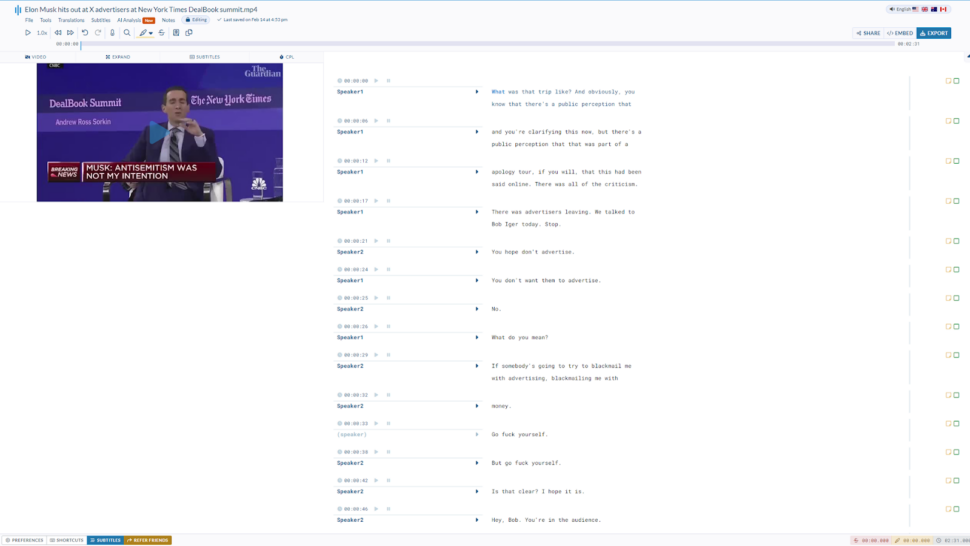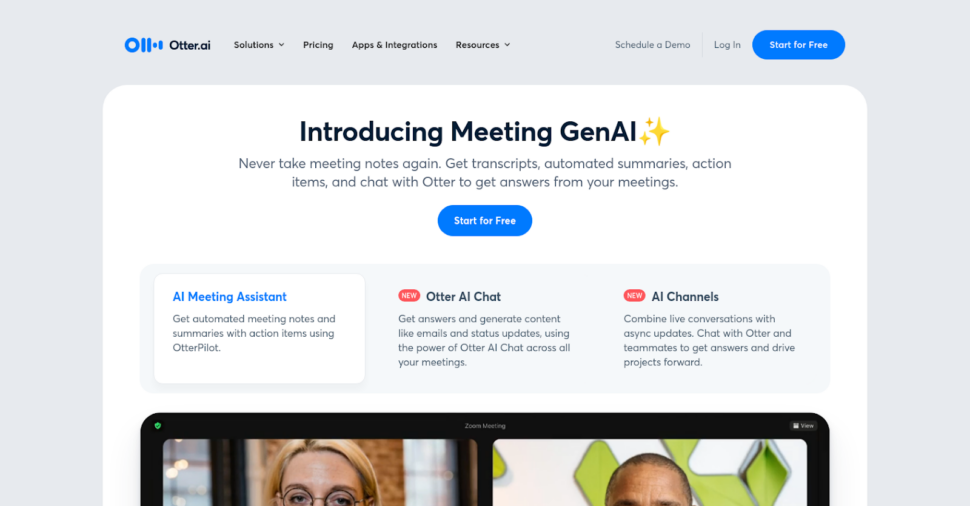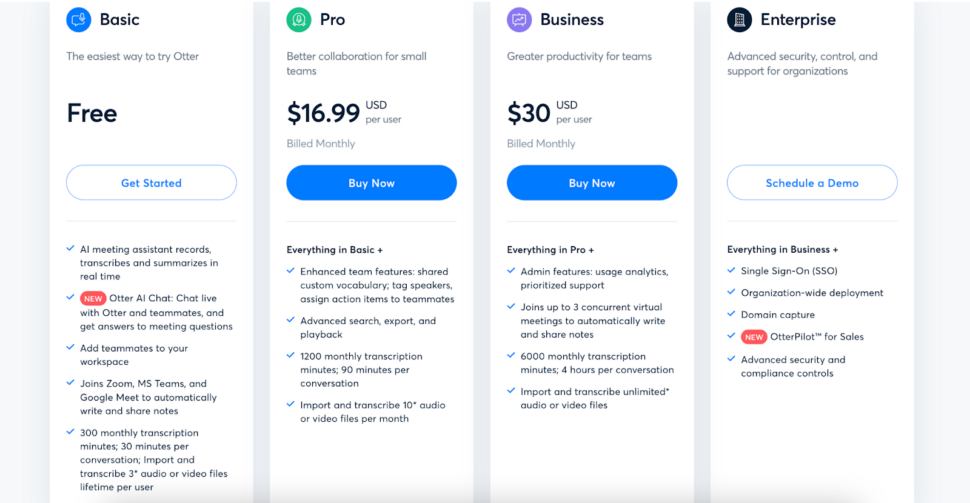Picking out a transcription tool can be daunting, especially when accuracy, ease of use, and cost are top priorities. Descript, Otter, and Sonix each promise to deliver reliable transcription services, but which one truly stands out for your specific needs?
Whether you’re a journalist needing precise transcripts, a business professional looking to save time on meeting notes, or a content creator aiming for flawless subtitles, selecting the right tool is crucial.
In this article, we will compare these three popular transcription tools, examining their features, pricing, and overall performance. We’ll break down the key differences between Descript, Otter.ai, and Sonix, so you can make an informed decision based on your unique needs.
Descript vs. Otter.ai vs. Sonix at a Glance
Here’s a quick summary of the main differences between these three tools.
| Feature | Descript | Otter.ai | Sonix |
| Accuracy | Decent accuracy, but less so with poor audio | Good accuracy, struggles with poor audio | Very high accuracy, up to 99% |
| Language Support | 23+ languages and dialects | Only English | 49+ languages and dialects |
| Security Features | SOC 2 compliance, Auth0, data encryption | Basic security features, privacy concerns | SOC 2 Type 2 compliance, encryption, 2FA, penetration testing, security monitoring, and more |
| AI Features | Overdub voice cloning, video enhancement | Real-time transcription, speaker labeling | Summaries, chapters, thematic & sentiment analysis |
| Pricing | Starts at $19 for 10 hours of transcription | Free plan, $16.99/month Pro, $30/month Business | $10/hour for the standard package, $5/hour + $22/user/month for the premium package |
Sonix Overview

Sonix is an AI-powered transcription and translation platform that streamlines your workflow, saving you valuable time and effort.
With Sonix, you can easily convert audio and video files to text with exceptionally high accuracies of up to 99%, making it an ideal solution for content creators, researchers, and professionals across various industries.
Whether you need to transcribe interviews, podcasts, lectures, or meetings, Sonix has you covered with its user-friendly interface and advanced features.
Sonix Core Features
Here are some primary features of Sonix that make it the optimal choice for your transcription and translation needs.
1. Highly Accurate Transcription and Translation
Sonix stands out with its exceptional accuracy in transcription and translation, boasting a 99% accuracy rate. This precision ensures that every word is captured accurately, minimizing the need for extensive editing and correction.
The advanced algorithms and machine learning models employed by Sonix are designed to handle 49+ languages and dialects.
Once your transcript is ready, you can easily edit it using Sonix’s intuitive editor, which allows you to make changes directly in the transcript while listening to the audio.

2. Security Protocols
At Sonix, we prioritize your data security with enterprise-grade measures designed to protect your files and information. Here’s an overview of Sonix’s robust security features.
| Feature | Description |
| SOC 2 Type 2 Compliance | Sonix adheres to strict global standards, reflecting our commitment to your security and trust. |
| Data Transfer Encryption | Your data is secured during transfer with encryption comparable to that used by banks. |
| Data Storage Encryption | Information hosted on Sonix servers is encrypted, safeguarding your sensitive data. |
| Secure Data Centers | Our facilities are fortified against both physical and digital intrusions. |
| Two-Factor Authentication (2FA) | A six-digit security code generated on your device adds an extra layer of protection against unauthorized access. |
| Security Monitoring | We vigilantly monitor servers to proactively address any security concerns. |
| AI Training Data Privacy | We ensure your data remains confidential and is not used to train AI models. |
| Regular Penetration Testing | Continuous reinforcement of security defenses protects your data from emerging threats. |
3. AI Analysis Tools
Sonix AI offers advanced AI analysis features designed to enhance your transcription and translation tasks. These features leverage cutting-edge technology to provide insightful and efficient solutions for various needs. Here are some key highlights:
- Generate Summaries: Sonix’s AI technology distills long, complex transcripts into concise summaries, providing actionable insights at lightning speed.
- Create Chapters: Automatically generates structured chapter headings for any audio or video file, saving time and enhancing accessibility by eliminating manual chaptering.
- Thematic Analysis: Uses AI to uncover themes, topics, and patterns within your data, identifying common threads and revealing key insights efficiently.
- Sentiment Analysis: Discerns the emotions behind the words with AI-powered technology, sifting through text data to determine sentiment with high accuracy.
- Topic Detection: Swiftly identifies and categorizes every topic within your transcript, providing comprehensive topic summaries and relevant timestamps.
- Entity Detection: Identifies and categorizes people, places, and things within your transcripts, providing relationships and relevant timestamps for each entity.
4. Collaboration Tools
Sonix enhances team collaboration with robust features tailored for seamless remote work. The secure read-only sharing option lets you share transcripts via a protected link, ensuring data integrity.
The share and edit feature allows team members to view and edit transcripts through email invitations, promoting real-time collaboration.
With multi-user access, teams can work together on content simultaneously. The user permissions management tool helps you control who can view or edit documents, maintaining security and organization.
Lastly, the shared team folder provides a centralized location for all team transcripts, streamlining access and collaborative efforts.
Sonix guarantees that your team can effectively collaborate and transcribe content without the need for third-party software.
5. Third Party Integrations
Sonix offers a range of integrations to enhance your workflow and streamline processes. These integrations ensure that you can seamlessly connect Sonix with the tools and platforms you already use, making your transcription and translation tasks more efficient. Here are some tools that Sonix can integrate with.
- Storage Platforms: Dropbox, Google Drive, OneDrive, Box
- Productivity Tools: Zapier, Evernote, Salesforce, Roam Research
- Research Tools: Atlas.ti, nVivo, MaxQDA
- Multimedia Editors: Adobe Premiere, Adobe Audition, Final Cut Pro X, Avid Media Composer
- Web Conferencing: Zoom, Microsoft Teams, Google Meet, Cisco WebEx
- Communication Platforms: Gmail, RingCentral, Skype, Loom
These integrations streamline processes, improve accessibility, and foster efficient collaboration across various tools and platforms.
Sonix Pricing

- Standard Plan: $10 per hour, billed as you go. Ideal for occasional users or those with smaller transcription needs.
- Premium Plan: $5 per hour + $22 per user per month. Suitable for frequent users or teams requiring collaboration features and additional storage.
- Enterprise Plan: Custom pricing based on volume and specific requirements. Perfect for large organizations with high-volume transcription needs and advanced security and integration demands.
Try Sonix’s free trial today and get 30-minutes of free transcription. No credit card required.
Positives of Sonix
- Accuracy: Sonix’s advanced AI technology ensures highly accurate transcriptions, saving you time on manual corrections.
- Speed: With fast turnaround times, you can get your transcripts back in minutes, not hours or days.
- Free Trial: Sonix has an amazing free trial that comes with 30 minutes of free transcription with full access to all of its features.
- Collaboration: Sonix’s collaboration tools make it easy to work with team members and clients on transcription projects.
- Subtitles: The platform’s automated subtitle generation feature is a valuable addition for content creators.
What Could Be Better
- Mobile app: While Sonix offers a web-based platform, a mobile app could provide added flexibility for users who need to transcribe on the go.
Descript Overview

Descript is an audio and video editing platform that simplifies the creation and production process for podcasters, video creators, and content producers. With its intuitive interface and powerful features, Descript allows users to edit their content by simply editing the transcript, making the process more accessible and efficient.
Descript Core Features
1. Transcription and Editing
Descript automatically transcribes your audio or video files, allowing you to edit your content by making changes directly to the transcript. This unique approach to editing eliminates the need for complex timelines and makes the process more intuitive for users who are more comfortable working with text.
The platform supports multiple languages and offers high accuracy in its transcriptions. Once the transcript is generated, you can easily delete, rearrange, or replace words, phrases, or entire sections of your content. Descript synchronizes the changes made in the transcript with the corresponding audio or video, ensuring a seamless editing experience.
However, it’s important to note that Descript is not mainly a transcription tool; it’s an AI editing software with transcription as a small part of its overall services. This might result in less frequent updates to their ASR (Automatic Speech Recognition) software. If that’s a dealbreaker for you, there are other Descript alternatives you should potentially consider.
2. Overdub and Voice Cloning
Descript’s Overdub feature allows users to create an AI-generated clone of their voice, enabling them to make edits or add new content without the need for re-recording. By providing a sample of your voice, Descript can generate a realistic voice clone that can be used to modify existing audio or create entirely new segments.
This feature is particularly useful for fixing mistakes, updating information, or adding new sections to your content without the hassle of setting up a recording session. Overdub can save time and effort while maintaining the consistency of your voice throughout the project.
3. Video Editing and Enhancement
In addition to its audio editing capabilities, Descript offers a range of video editing and enhancement tools. Users can easily trim, split, or rearrange video clips by making changes to the transcript. The platform also provides a variety of video effects and transitions to help polish your content.
Descript’s video enhancement features include:
- Automatic Video Leveling: Ensures consistent volume levels throughout your video.
- Background Noise Removal: Eliminates unwanted background noise for clearer audio.
- Visual Effects: Offers a variety of visual effects and filters to enhance your video’s appearance.
- Automatic Captioning: Generates captions based on the transcribed audio, improving accessibility for your audience.
Descript Pricing

- Free: Includes 3 hours of transcription per month, basic editing features, and watermarked exports.
- Hobbyist: Offers 10 hours of transcription per month, advanced editing features, and watermark-free exports for $19/editor/month.
- Creator: Provides 30 hours of transcription per month, professional-level features, and priority support for $35/editor/month.
- Business: Comes with 40 hours of transcription at a price of $40/month.
Positives of Descript
- Intuitive Editing: Descript’s transcript-based editing makes the process more accessible for users who are not familiar with traditional audio or video editing tools.
- Time-saving Features: Overdub and automatic transcription can significantly reduce the time spent on editing and re-recording.
- Collaboration Tools: Descript allows users to collaborate on projects in real-time, making it easier for teams to work together on content creation.
- Versatile Platform: With its combination of audio and video editing tools, Descript caters to a wide range of content creators, from podcasters to video producers.
What Could Be Better
- Learning from Mistakes: Descript’s transcription software doesn’t learn from past mistakes, requiring users to repeatedly correct the same errors in transcripts.
- Handling Crosstalk: Descript struggles with crosstalk, blending sentences from overlapping speakers, making conversations difficult to sort accurately.
- Security Features: Despite having SOC 2 compliance, Auth0, and data encryption, Descript’s security features are less comprehensive compared to tools like Sonix.
- Language Support: Descript supports over 23 languages, more than some competitors, but falls short of Sonix’s extensive language support.
- Pricing Model: Descript transcribes each speaker in a multi-speaker file separately, consuming more transcription minutes. A 30-minute audio with three speakers uses 90 minutes.
Otter.ai Overview

Otter.ai is an AI-powered transcription and collaboration platform that converts speech to text in real time. It is designed to help users capture and share insights from meetings, lectures, interviews, and other spoken conversations. With its intuitive interface and powerful features, Otter.ai streamlines the process of creating, searching, and sharing transcripts, making it an invaluable tool for professionals, students, and content creators.
Otter.ai Core Features
1. Real-time Transcription
Otter.ai’s real-time transcription feature is powered by advanced AI algorithms that accurately convert speech to text as the conversation unfolds. The platform supports multiple speakers and can distinguish between different voices, automatically assigning speaker labels to the transcript.
Users can access the live transcript during the meeting or conversation, allowing them to follow along, highlight important points, and add comments or images to provide context. After the meeting, the transcript is available for review, editing, and sharing.
However, one of the main drawbacks of Otter’s transcription tool is the lack of language support. Their tool is only capable of transcribing content in English, which is a severe deterrent for customers who work with multilingual content. If you’re one of those customers, here are some Otter alternatives you should consider.
2. Collaboration Tools
Otter.ai offers a range of collaboration features that enable teams to work together seamlessly on transcripts and notes. These features include:
- Shared Workspaces: Create dedicated workspaces for teams, projects, or departments to keep transcripts organized and accessible.
- Comments and Highlights: Add comments and highlight important sections of the transcript to draw attention to key points and facilitate discussion.
- Inline Images: Attach relevant images to the transcript to provide visual context and enhance understanding.
- Folder Organization: Organize transcripts into folders for easy navigation and quick access to specific topics or meetings.
3. Integrations and Apps
Otter.ai integrates with popular productivity tools and platforms to streamline workflows and enable users to access transcription capabilities within their existing ecosystems. Key integrations include:
- Video Conferencing: Otter.ai integrates with Zoom, Microsoft Teams, and Google Meet, allowing users to transcribe meetings in real-time directly from these platforms.
- Calendar Sync: Connect Otter.ai with Google Calendar, Microsoft Outlook, or Apple Calendar to automatically import and transcribe scheduled meetings.
- Mobile Apps: Otter.ai offers mobile apps for iOS and Android devices, enabling users to record, transcribe, and access their conversations on the go.
- Chrome Extension: The Otter.ai Chrome extension allows users to transcribe audio and video content directly from their web browser.
Otter.ai Pricing

- Basic: Free plan with limited features and transcription minutes.
- Pro: $16.99 per month, offering advanced features and increased transcription minutes for individuals and small teams.
- Business: $30 per month, providing enhanced collaboration tools and admin controls for teams and organizations.
- Enterprise: Custom pricing and features tailored to large organizations with specific security and compliance requirements.
Positives of Otter.ai
- Ease of Use: The platform’s intuitive interface and straightforward workflow make it easy for users to record, transcribe, and share conversations.
- Collaboration Features: Otter.ai’s collaboration tools enable teams to work together efficiently on transcripts, improving productivity and knowledge sharing.
- Integrations: The platform’s integrations with popular tools like Zoom, Google Meet, and Slack allow users to seamlessly incorporate transcription into their existing workflows.
What Could Be Better
- Speaker Identification: While Otter.ai can distinguish between different speakers, it may struggle with accurately identifying and labeling speakers in larger group conversations.
- Language Support: Otter.ai primarily supports English, with limited support for other languages, which may be a drawback for users who need transcription in multiple languages.
- Accuracy: Otter is great for recording real-time conversations and meetings, but its accuracy rate of 83% leaves something to be desired.
Descript vs. Otter.ai vs. Sonix: Transcription Accuracy
Descript provides automated transcription with high accuracy for clear audio. It supports over 20 languages and dialects. However, accuracy may decrease for poor audio quality or heavy accents.
Otter.ai offers real-time transcription with good accuracy in over 35 languages. Its AI algorithms effectively handle background noise and multiple speakers. But very poor audio can still impact the transcription quality.
Sonix delivers industry-leading automated transcription accuracy. Powered by advanced AI, it supports over 49+ languages and can consistently transcribe content with over 99% accuracy.
Descript vs. Otter.ai vs. Sonix: Security Features
When comparing the security features of Descript, Otter, and Sonix, there is a clear winner between the three.
Descript offers strong security with SOC 2 compliance, Auth0, and data encryption, but its features are not as extensive as those provided by Sonix.
Sonix excels with a comprehensive suite of enterprise-grade security measures, including advanced data encryption, secure data centers, and robust user permission management, ensuring top-tier data protection.
On the other hand, Otter has basic security features but has raised privacy concerns among users, prompting many to seek alternatives.
For those prioritizing security, Sonix presents the most reliable option, followed by Descript, while Otter may lag behind.

Descript vs. Otter.ai vs. Sonix: Collaboration Features
Descript offers robust collaboration tools, allowing users to share transcripts, assign roles, leave comments, and track changes. Its intuitive interface makes it easy for teams to work together on transcription projects.
Otter.ai provides basic collaboration features like shared workspaces, commenting, and highlighting. However, it lacks some advanced functionalities like role assignment and change tracking that Descript offers.
Sonix enables seamless collaboration by allowing users to securely share transcripts, set access permissions, leave notes, and see edit history. Its collaboration suite is comprehensive yet user-friendly.
Descript vs. Otter.ai vs. Sonix: Pricing
Descript’s pricing starts at $19/editor/month for the Hobbyist plan, which includes 10 transcription hours. The Creator plan at $35/editor/month offers 30 transcription hours. Enterprise pricing is available for larger teams.
Otter.ai offers a free Basic plan with limited features. The Pro plan starts at $16.99/month, billed annually, with more transcription hours. The Business plan at $30/month adds advanced features for teams.
Sonix provides affordable pay-as-you-go pricing at $10/hour for the Standard plan, ideal for occasional use. The Premium plan at $5/hour plus $22/user/month suits frequent users. Custom Enterprise plans are available for high-volume needs.
Out of these three tools, Descript is the most affordable. However, it’s important to note that for a lesser price, you’re getting fewer languages and much lesser accuracy rates. Furthermore, Descript’s pricing tiers make it impossible to scale with that tool.
If you’re looking for the best price-to-performance ratio, Sonix is the most affordable and most scalable transcription platform.
Descript vs. Otter.ai vs. Sonix: Which Should You Choose?
To help you make an informed decision, here’s a scoring table comparing key features of Descript, Otter.ai, Sonix, and Sonix on a 5-point scale:
| Feature | Descript | Otter.ai | Sonix |
| Transcription Accuracy | 4.5 | 4.2 | 4.9 |
| Security Features | 3.8 | 3.0 | 4.8 |
| Language Support | 3.5 | 2.0 | 4.5 |
| Collaboration Features | 4.5 | 3.8 | 4.8 |
| Ease of Use | 4.4 | 4.6 | 4.7 |
| Pricing | 4.2 | 4.5 | 4.6 |
| Average Score | 4.1 | 3.6 | 4.7 |
Get Started with Sonix
Sonix stands out due to its industry-leading transcription accuracy and advanced AI technology, which ensures that even suboptimal audio can be transcribed accurately. The platform’s comprehensive collaboration tools make it easy for teams to work together seamlessly on transcription projects.
With support for over 49+ languages, Sonix offers versatility and customization options that cater to a global user base. Its intuitive interface and fast turnaround times save you valuable time and effort, making it a practical choice for content creators, researchers, and professionals.
The affordable pricing structure, including a pay-as-you-go option, ensures that you only pay for what you need. This flexibility, combined with Sonix’s robust features, makes it the best choice among Descript, Otter.ai, and Sonix.Try Sonix’s world-renowned transcription services today. Get 30-minutes of free transcription now. No credit card required.
World's Most Accurate AI Transcription
Sonix transcribes your audio and video in minutes — with accuracy that'll make you forget it's automated.






